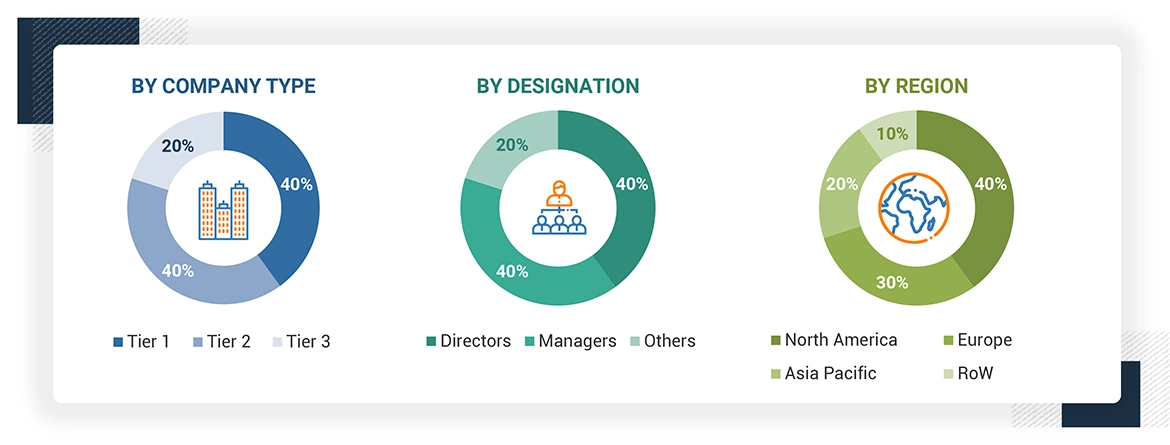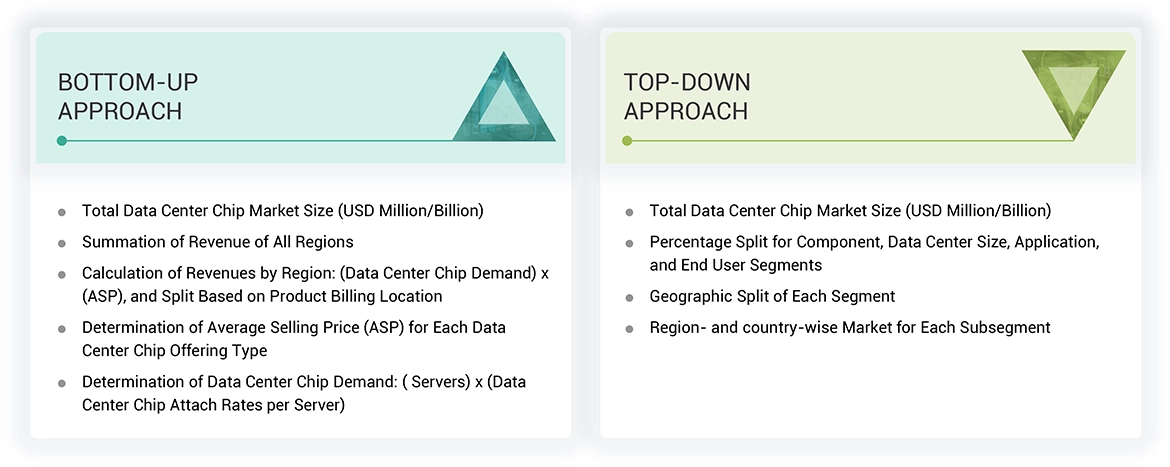The study involved four major activities in estimating the current size of the data center chip market—exhaustive secondary research collected information on the market and its peer and parent markets. The next step was to validate these findings, assumptions, and sizing with industry experts across the value chain through primary research. Both top-down and bottom-up approaches were employed to estimate the total market size. After that, market breakdown and data triangulation were used to estimate the market size of segments and subsegments.
Secondary Research
Various secondary sources have been referred to in the secondary research process to identify and collect information important for this study. These secondary sources include data center chip technology journals and magazines, annual reports, press releases, investor presentations of companies, white papers, certified publications and articles from recognized authors, and directories and databases such as Factiva, Hoovers, and OneSource.
Primary Research
Various primary sources from both supply and demand sides have been interviewed in the primary research process to obtain qualitative and quantitative information important for this report. The primary sources from the supply side included industry experts such as CEOs, VPs, marketing directors, technology and innovation directors, and related executives from key companies and organizations operating in the data center chip market. After complete market engineering (including calculations regarding market statistics, market breakdown, market size estimations, market forecasting, and data triangulation), extensive primary research was conducted to gather information as well as to verify and validate the critical numbers arrived at.

Note: Other designations include sales, marketing, and product managers. Tier 1 = USD 1 billion, Tier 2 = USD 0.5–1.0 billion, and Tier 3 = USD 0.5 billion.
To know about the assumptions considered for the study, download the pdf brochure
Market Size Estimation
In the complete market engineering process, both top-down and bottom-up approaches, along with several data triangulation methods, have been used to perform the market size estimation and forecasting for the overall market segments and subsegments listed in this report. Extensive qualitative and quantitative analyses have been conducted on the complete market engineering process to list the key information/insights throughout the report.
The key players in the market, such as Intel Corporation (US), NVIDIA Corporation (US), Google (US), Advanced Micro Devices, Inc. (US), and Micron Technology, Inc. (US), have been identified through secondary research and their market shares in the respective regions have been determined through primary and secondary research. This entire procedure includes the study of annual and financial reports of the top players as well as extensive interviews with industry experts (such as CEOs, VPs, directors, and marketing executives) for key insights (both quantitative and qualitative) on the data center chip market. All percentage shares, splits, and breakdowns have been determined using secondary sources and verified through primary sources. All the possible parameters that affect the markets covered in this research study have been accounted for, viewed in extensive detail, verified through primary research, and analyzed to get the final quantitative and qualitative data. This data has been consolidated and supplemented with detailed inputs and analysis from MarketsandMarkets and presented in this report.
Data Center Chip Market : Top-Down and Bottom-Up Approach
The bottom-up approach has been employed to arrive at the overall size of the data center chip market. The bottom-up methodology for data center chip market calculations begins with determining data center chip demand by multiplying server numbers by chip attach-rates per server. Average Selling Prices for each data center chip offering type are then identified. Revenues are calculated for each region or country by multiplying the local data center chip demand by the corresponding ASP, considering product billing locations. These regional revenues are summed to provide a global figure. The total market size is derived by combining all calculated revenues
In the top-down approach, the overall market size has been used to estimate the size of the individual markets (mentioned in the market segmentation) through percentage splits from secondary and primary research. The top-down methodology for the data center chip market analysis starts with the total market size as the foundation. This figure is then divided into percentage splits for key segments such as Component, Data Center Size, Application, and End User. Each segment is further divided into geographic regions, clearly showing market distribution across different areas. The analysis then delves deeper, offering region and country-wise splits for each sub-segment. This approach allows for a comprehensive market view, starting from the broadest perspective and progressively narrowing down to specific details. This provides an effectively mapped-out entire data center chip market landscape, identifying trends, opportunities, and potential growth areas across various dimensions and geographical locations.

Data Triangulation
After arriving at the overall market size from the estimation process explained above, the global market has been split into several segments and subsegments. Market breakdown and data triangulation procedures have been employed wherever applicable to complete the overall market engineering process and arrive at exact statistics for all segments and subsegments. The data has been triangulated by studying various factors and trends identified from both the demand and supply sides.
Market Definition
Considering the views of various sources and associations, a data center is a centralized facility that houses computing, storage, and networking equipment, along with the necessary infrastructure for managing and processing large volumes of data, supporting organizations' IT requirements. Data center chip market refer to a comprehensive set of components and technology designed to optimize, manage, and enhance the efficiency, reliability, and security of data centers.
Key Stakeholders
-
Government and financial institutions and investment communities
-
Analysts and strategic business planners
-
Semiconductor product designers and fabricators
-
Application providers
-
AI solution providers
-
AI platform providers
-
Business providers
-
Professional service/solution providers
-
Research organizations
-
Technology standard organizations, forums, alliances, and associations
-
Technology investors
Report Objectives
The following are the primary objectives of the study.
-
To describe and forecast the data center chip market size, in terms of value and volume, by component, application, data center size, end user, and region
-
To describe and forecast the market size across four key areas, namely, North America, Europe, Asia Pacific, and Rest of the World (RoW), along with their respective country-level market size, in terms of value
-
To provide detailed information regarding the drivers, restraints, opportunities, and challenges of the data center chip market
-
To strategically analyze the micromarkets1 concerning the individual growth trends, prospects, and their contribution to the data center chip market
-
To map competitive intelligence based on company profiles, key player strategies, and key developments
-
To provide a detailed overview of the data center chip value chain and ecosystem
-
To provide information about the key technology trends and patents related to the data center chip market
-
To provide a detailed overview of the supply chain, ecosystem analysis, case study analysis, patent analysis, trade analysis, technology analysis, average selling price (ASP) analysis, AI/gen AI impact analysis, Porter's five forces analysis, macroeconomic outlook, and regulations about the market of the data center chip.
-
To benchmark the market players using the proprietary company evaluation matrix framework, which analyzes them on various parameters within the broad categories of market ranking/share and product portfolio
-
To analyze competitive developments such as contracts, acquisitions, product launches and developments, collaborations, and partnerships, along with research & development (R&D), in the data center chip market
Available Customizations
With the given market data, MarketsandMarkets offers customizations according to a company’s specific needs. The following customization options are available for the report:
Company Information:
-
Detailed analysis and profiling of additional market players (up to 5)

Growth opportunities and latent adjacency in Data Center Chip Market